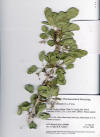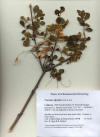|
Fraxinus anomala |
Fraxinus anomala
|
Fraxinus dipetala Shasta Co., CA |
|
Fraxinus dipetala Riverside Co., San
Bernardino Natl. For.., CA. Spjut & Marin 14710
|
|
Trinity Co., CA |
Fraxinus lowellii Sarg. Arizona Desert. Gila Co.,
Tonto NF: 10 mi northwest of Payson just off Hwy 87 |
  Fraxinus
trifoliata |
|
|
Trees and Shrubs of Kern County (Jan 2013) Fraxinus. Deciduous shrubs or trees with opposite odd pinnate leaves, or reduced to 1 leaflet in F. anomala; flowers appearing with or before leaves, unisexual on different plants, or bisexual, sepals 4 or absent, petals absent or present, 4 in 2 pairs, or 2; fruit a samara. ± 65 species, temperate and subtropical northern hemisphere, often a major component of broad-leaved deciduous forests. Extremely variable species. Key to Fraxinus
Lateral leaflets not overlapping, tapered to a stalk-like (petiole)
base;
Lateral leaflets often touching or overlapping, abruptly tapered at
Fraxinus latifolia Bentham 1844. Oregon Ash. Deciduous tree to 25 m; leaves opposite, compound, usually divided into two or three pairs of lateral leaflets and one terminal odd leaflet (odd pinnate), leaflets broad elliptical to wider above the mid region, about twice as long as wide, 24.5 cm long; fruit a samara, usually falling soon after maturing. Near streams below 5,500 ft. California to British Colombia. Type from San Francisco, CA. Oregon ash groves recognized in MCV2 when >5% absolute cover in the tree canopy with a note stating that south of the Kern River F. latifolia is similar to F. velutina. Kern Co.: Occasional in Kern Canyon just above Kernville north to Tulare County, and in the Greenhorn Range to Wagy Flat, south to Caliente Canyon (Twisselmann), 6091,021 m (CCH). Noted by Twisselmann to freely intergrade with F. velutina, which he did not consider distinct from F. latifolia, including F. velutina var. coriacea (S. Watson) Rehder; Fraxinus latifolia Woodland Alliance (riparian) recognized on the Tejon Ranch Conservancy (Magney 2010). Fraxinus velutina Torrey 1848. Arizona ash. Type from the region between the waters of the Del Norte and the Gila; also on the Mimbres, a tributary of the latter river, NM. CCH: Southern Sierra Nevada, Owens Peak Watershed, North Fork of Grapevine Canyon (Fraga & Mills), Short Canyon (Fraga & Griffith). Mojave Quad., Back Canyon (F. H. Raymond & R. St. John, 18 Jun 1931); Bloomfield Ranch, Onyx (E. Voegelin, 3 Aug 1932); Mojave Wash (Hoffmann, 24 Jul 1932), 7611,523 m.
Eyles A, W. Jones, K. Riedl, D. Cipollini, S. Schwartz, K. Chan, D. A. Herms and P. Bonello. 2007. Comparative phloem chemistry of Manchurian (Fraxinus mandshurica) and two North American ash species (Fraxinus americana and Fraxinus pennsylvanica). J. Chem. Ecol. 33(7):14301448. Recent studies have investigated interspecific variation in resistance of ash (Fraxinus spp.) to the exotic wood-boring beetle, emerald ash borer (EAB, Agrilus planipennis). Manchurian ash (Fraxinus mandshurica) is an Asian species that has coevolved with EAB. It experiences little EAB-induced mortality compared to North American ashes. Host phloem chemistry, both constitutive and induced, might partly explain this interspecific variation in resistance. We analyzed the constitutive phloem chemistry of three ash species: Manchurian ash and North American white (Fraxinus americana) and green (Fraxinus pennsylvanica) ash. Analysis of the crude phloem extracts revealed the presence of an array of phenolic compounds including hydroxycoumarins, a monolignol, lignans, phenylethanoids, and secoiridoids. Both qualitative and quantitative differences were observed among the three ash species. Hydroxycoumarins and the phenylethanoids, calceloariosides A and B, were present only in the phloem of Manchurian ash and might represent a mechanism of resistance against EAB. Heuertz M., S. Carnevale, S. Fineschi, F. Sebastiani, J. F. Hausman, L. Paule and G. G. Vendramin. 2006. Chloroplast DNA phylogeography of European ashes, Fraxinus sp. (Oleaceae): roles of hybridization and life history traits. Mol. Ecol. 15(8): 21312140. We investigated range-wide phylogeographic variation in three European ash species (Fraxinus sp., Oleaceae). Chloroplast DNA (cpDNA) microsatellites were typed in the thermophilous Fraxinus angustifolia and Fraxinus ornus and the observed haplotypes and the geographic distribution of diversity were compared to cpDNA data previously obtained in the more cold-tolerant Fraxinus excelsior. We found wide-ranging haplotype sharing between the phylogenetically close F. angustifolia and F. excelsior, suggesting hybridization (i) in common glacial refuges in the Iberian Peninsula, northern Italy, the eastern and/or Dinaric Alps and the Balkan Peninsula, and/or (ii) during postglacial recolonization. The data allowed us to propose additional glacial refuges for F. angustifolia in southern Italy and in Turkey, and populations from the latter region were particularly polymorphic. There was evidence for refuge areas in Italy, the Balkan Peninsula and Turkey for F. ornus, which did not share any single chloroplast haplotype with the other species. In both F. angustifolia and F. ornus, cpDNA diversity (h(S) = 0.027 and h(S) = 0.009, respectively) was lower and fixation levels (G(ST) = 0.964 and G(ST) = 0.983, respectively) higher than in sympatric F. excelsior (h(S) = 0.096, G(ST) = 0.870). These diversity patterns could be due to temperature tolerance or the demographic history. Jeandroz S., A. Roy and J. Bousquet . 1997. Phylogeny and phylogeography of the circumpolar genus Fraxinus (Oleaceae) based on internal transcribed spacer sequences of nuclear ribosomal DNA. Mol. Phylogenet. Evol. 7(2): 241251. The DNA sequences of the nuclear internal transcribed spacers (1 and 2) of nuclear ribosomal DNA were determined for 27 taxa of Fraxinus in an attempt to reconstruct the phylogeny of the genus and interpret its biogeographic history in a phylogenetic context. Minimal intra-individual and intraspecific polymorphisms were observed and infrageneric taxa were all recovered in phylogenetic analyses. The tree topologies estimated from parsimony and neighbor-joining analyses of one- and two-parameter substitution rates were congruent and supported by high bootstrap estimates. Indels were also found to be phylogenetically informative. The phylogenetic trees obtained were in quite good agreement with the current taxonomy of the genus but homoplasy was observed in the evolution of floral characters. Polyploidy also appeared to have evolved several times in the genus. Fraxinus nigra was more closely related to European and Asian taxa than to the other American ashes. The Asian F. platypoda had a closer relationship to Asian and European ashes in section Bumelioides than to its presumed North American allies of section Melioides. With respect to the position of F. quadrangulata as sister group to the remainder to the remaining species, the subgenus Fraxinus appeared paraphyletic. Phylogeographical analysis indicated that Fraxinus likely originated in North America, with two subsequent events of intercontinental migration from North America to Asia. Kostova I. and T. Iossifova. 2007. Chemical components of Fraxinus species. Fitoterapia. 78(2): 85106. Review. A wide range of chemical components including coumarins, secoiridoids, phenylethanoids, flavonoids, and lignans has been isolated from Fraxinus species. Extracts and metabolites have been found to possess antiinflammatory, immunomodulatory, antimicrobial, antioxidative, skin regenerating, photodynamic damage prevention, liverprotecting, diuretic and antiallergic activities. Some species find application in contemporary medicine. In the present review the literature data on the phytochemical and biological investigations on the genus Fraxinus are summarized up to the middle of 2004. Lin S., S. Wang, M. Liu, M. Gan, S. Li, Y. Yang, Y. Wang, W. He and J. Shi. 2007. Glycosides from the stem bark of Fraxinus sieboldiana. J. Nat. Prod. 70(5): 817823. A norditerpene glucopyranoside with a novel carbon skeleton (1), eight new aromatic glycosides (2-9), and 25 known glycosides have been isolated from a H2O-soluble portion of an ethanolic extract of the stem bark of Fraxinus sieboldiana. Their structures were determined by spectroscopic and chemical methods. Based on analysis of the NMR data of threo- and erythro-arylglycerols in different solvents, an application of Delta delta C8-C7 values to distinguish threo-arylglycerol and erythro-arylglycerol isomers was proposed. In the in vitro assays, compound 5 displayed TNF-alpha secretion inhibitory activity with an IC50 value of 1.6 microM, compound 6 showed antioxidative activity inhibiting Fe+2-cystine-induced rat liver microsomal lipid peroxidation with an IC50 value of 0.9 microM, and plantasioside (10) showed selective activity against the human colon cancer cell line (HCT-8) with an IC50 value of 3.4 microM. Zhao D. L., L. B. Zou, S. Lin, J. G. Shi and H. B. Zhu HB. 2007. Anti-apoptotic effect of esculin on dopamine-induced cytotoxicity in the human neuroblastoma SH-SY5Y cell line. Neuropharmacology 53(6): 724732. Dopamine (DA), as a neurotoxin, can elicit severe Parkinson's disease-like syndrome by elevating intracellular reactive oxygen species (ROS) levels and apoptotic activity. In this study, we examined the effect of esculin, which was extracted from Fraxinus sielboldiana Blume, on DA-induced cytotoxicity and the underlying mechanism in human neuroblastoma SH-SY5Y cells. Our results suggest that the protective effects of esculin (10(-7), 10(-6) and 10(-5) M) on DA-induced cytotoxicity may be ascribed to its anti-oxidative properties by reducing ROS level, and its anti-apoptotic effect via protecting mitochondrion membrane potential (DeltaPsim), enhancing superoxide dismutaese (SOD) activity and reduced glutathione (GSH) levels, and regulating P53, Bax and Bcl-2 expression. In addition, esculin inhibited the release of cytochrome c and apoptosis-inducing factor (AIF), and the protein expression of activated caspase 3. These data indicate that esculin may provide a useful therapeutic strategy for the treatment of progressive neurodegenerative diseases such as Parkinson's disease (PD).
|
||







